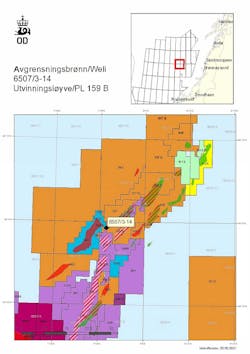Equinor Energy AS did not encounter hydrocarbons in Black Vulture appraisal well 6507/3-14 in the Norwegian Sea. While too early to provide an updated resource estimate for the discovery, the well is expected to yield a reduced estimate, the Norwegian Petroleum Directorate said in a release Sept. 28.
Before well 6507/3-14 was drilled, the resource estimate for the discovery in the Lange formation was 0.4-4.4 million standard cu m of recoverable oil equivalents.
The main purpose of the well was to detect hydrocarbons in reservoir rocks from the Early Cretaceous Age (Lange formations) in the Black Vulture prospect in PL159 B.
The well was drilled by the West Hercules semisubmersible drilling rig in 368 m of water about 15 km southwest of Norne field in the northern part of the Norwegian Sea, and 200 km west of Sandnessjøen to a vertical depth of 3,384 m below sea level. It was terminated in the Lyr formation from the Early Cretaceous.
The 6507/3-13 oil and gas discovery (Black Vulture) was proven in 2019 in reservoir rocks from the Early Cretaceous (oil and gas in the Lange formation) and the Late Cretaceous (gas in the Lysing formation).
The appraisal well encountered the Lange formation, about 45 m thick, of which a total of 24 m was sandstone layers with moderate reservoir properties. Weak traces of petroleum were encountered. The well is classified as dry.
Formation tests were not conducted, but data acquisition has been carried out. The well will be permanently plugged and abandoned.
This is the fifth exploration well in production license 159 B. The license was carved out from PL 159 in 2004.
The drilling rig will now drill wildcat well 6407/1-9 in production license 939 in the Norwegian Sea for Equinor.
Equinor is operator of PL159B with 53%. Partners are DNO Norge AS (32%) and Ineos E&P Norge AS (15%).
